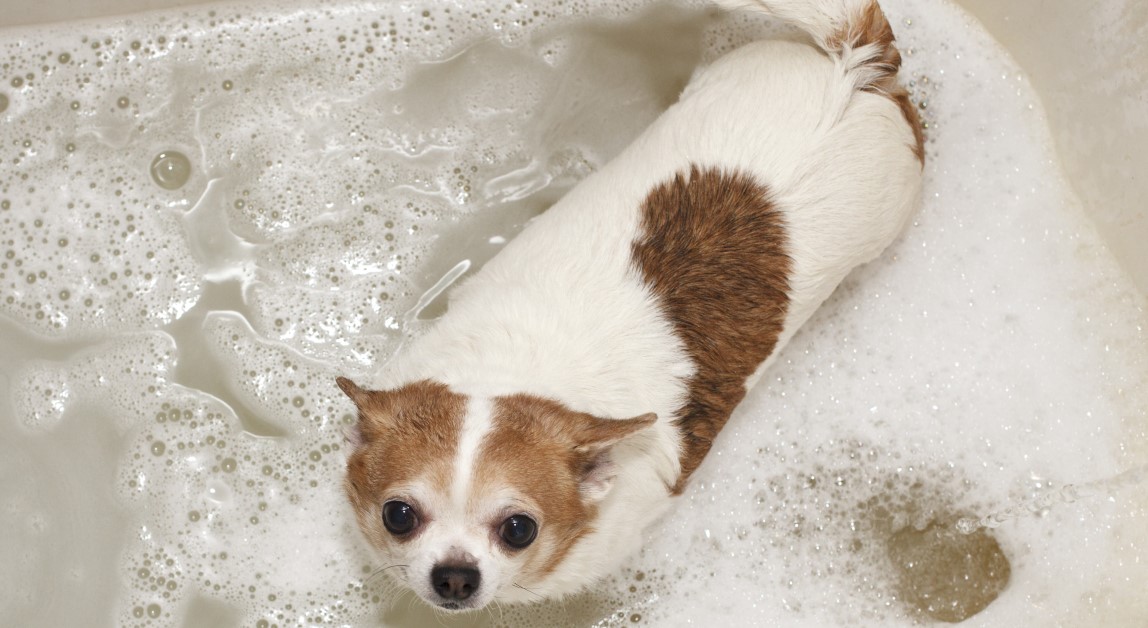How Often Should I Bathe My Pet?
Pets require regular baths to minimize dirt, oil buildup, and odors, but bathing shouldn’t be too frequent.

Unless your pet is rolling in the mud, you might overlook regular bathing. Much like their human counterparts, both cats and dogs require baths to remove dirt and debris from their skin and hair. However, there are many factors that influence how often you should bathe your pet, such as the animal’s breed, hair type, hair length, and activity level. The season should also be considered, as pet odors tend to be more obvious in the summer months compared to winter.
While regular baths can help keep your pet clean and healthy, too much of a good thing can be harmful. Let’s look at how often you should bathe your pet and the potential side effects of over-bathing.
How Often Should You Give Your Dog or Cat a Bath?
The skin is the largest organ that acts as a barrier against environmental factors, such as chemicals, temperature, and bacteria. Your pet’s coat also plays a role in temperature regulation and protects against trauma, chemical damage, and ultraviolet light.
Dirty or damaged skin or hair can disrupt your pet’s natural microbiome balance, increasing their risk of developing skin irritation and infection. Bathing is a simple solution to this issue. But how often should you bathe your pet? That will depend on the following factors:
Breed
The breed of your cat or dog will have a major impact on the condition of their skin and hair over time. For example, Golden Retrievers tend to have more oily coats and require a bath every four to six weeks to minimize oil buildup and odors. Bulldogs, hound breeds, and pugs are other examples of dogs that tend to develop odors fairly quickly.
Certain cat breeds, such as Himalayan and Persian cats, tend to suffer from disorders like idiopathic seborrhea which can cause oily skin and coat. A good grooming routine that involves regular bathing can help.
Coat Type and Length
One of the most important factors to consider when determining how often to bathe your pet is the coat type and length of hair. Dogs with thick double coats, such as Chow Chows and Siberian Huskies, tend to shed frequently and require less bathing. While daily brushing is recommended, a bath is only needed about every two to three months.
Dogs with wiry or short single coats, such as pitbulls and terriers, are relatively low-maintenance, only needing a bath about every three to four months unless they get visibly dirty. Dogs with non-shedding coats and soft, curly coats, such as Yorkshire Terriers and Poodles, tend to get dirty quickly and require a monthly bath.
Cats are great at self-grooming but those with long hair may need help removing excess dirt and oils. Long-haired pets can benefit from a bath every four to six weeks. Short-haired pets can go longer in between baths, averaging about every two to three months. Even hairless breeds need regular baths to eliminate excess body oils.
Activity Level
Cats and dogs that are very active tend to require more frequent baths than pets that are sedentary. Animals that tend to spend a lot of time outdoors, swimming, or rolling around in the grass get dirty rather quickly. Senior pets do not generally need as many baths as most prefer to stay indoors rather than play outside.
Health Conditions
If your pet has a health condition, particularly a skin condition, it may require more baths than animals that are healthy. Speak with your vet about the use of medicated shampoos or other treatments that may be necessary to keep the skin and coat healthy during and after baths.
What are the Potential Dangers of Over-Bathing?
Sticking to a healthy bathtime routine that is appropriate for your pet’s age, breed, health, and activity levels is essential to avoid potential health risks.
While most healthy dogs and cats can be bathed regularly without any side effects, bathing too frequently can compromise the animal’s hair quality, irritate the skin, and increase their risk of infection.
In comparison, bathing your pet too infrequently can lead to irritated skin and a dry coat, and increase the odds of fleas and other infestations. Some pets may also experience itchy and flaky skin, greasy or oily fur, and a decrease in coat quality.
Why Do I Need to Regularly Bathe My Dog or Cat?
While many animals attempt to clean themselves, there are situations in which licking is not enough. Bathing your cat or dog regularly not only helps your pet smell better, but can also reduce shedding, remove dirt and debris from the fur, and help prevent certain skin conditions.
While bathing your pet, perform a simple physical examination of the skin, ears, paws, and nails. Look for signs of problems, such as redness, swelling, or unusual bumps or sores. You can also use this time to look for mites, ticks, or fleas your pet may have picked up.
As not all cats and dogs enjoy getting a bath, it may be best to leave this task up to the professionals. Consider bringing your pet to a professional groomer who will perform important services like bathing, brushing, and other forms of grooming based on your pet’s unique needs.
Ready to start saving money on pet wellness care?
Then take a look at Mint Wellness, the pet wellness plan that provides fast reimbursement on routine pet care. Save on vaccinations, wellness exams, preventatives, dental, and more!
Learn More


